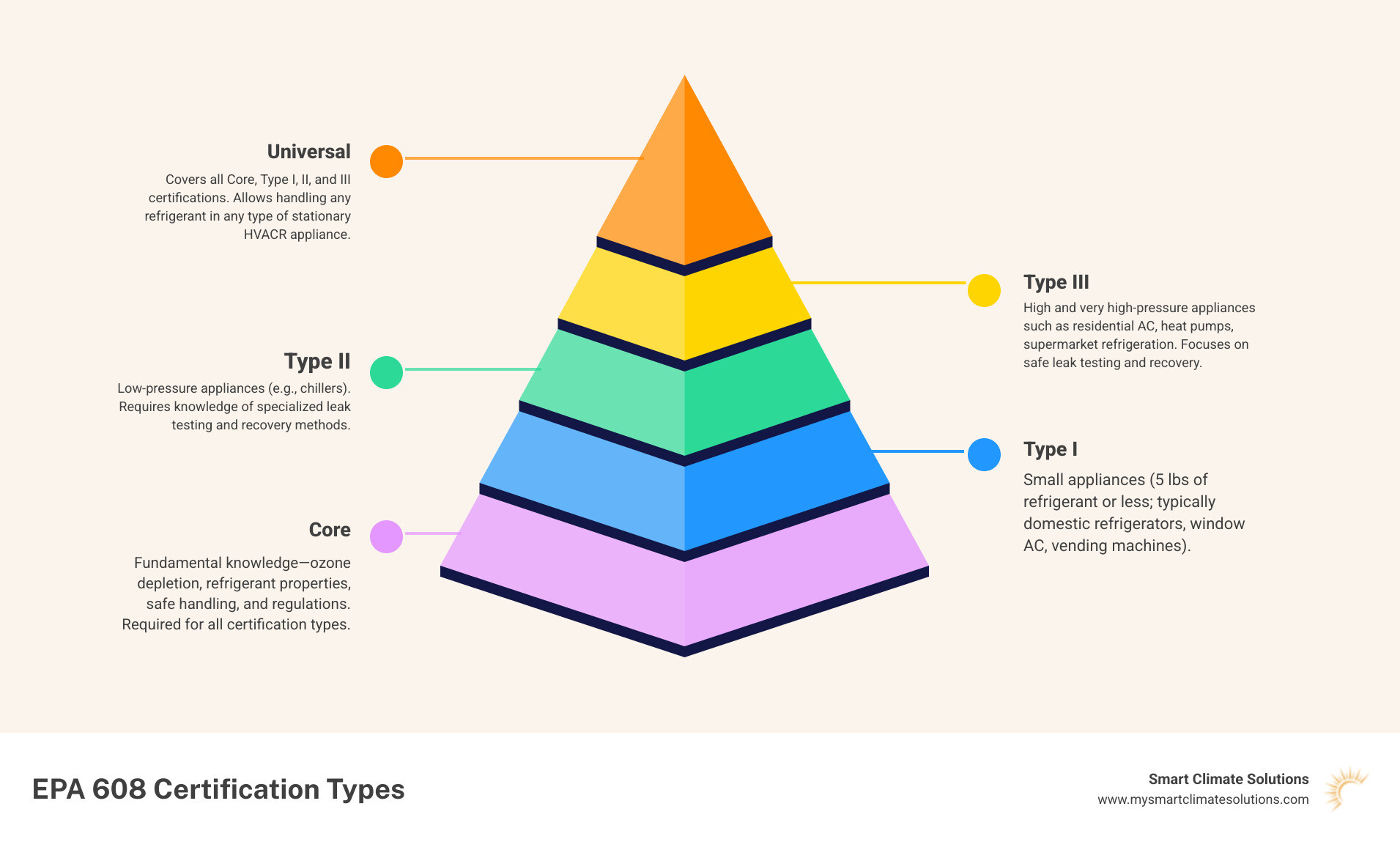What Is EPA Section 608 Certification?
If you handle refrigerants in the United States, Section 608 certification is the federal permission slip you need. Issued under the Clean Air Act, it proves you know how to keep ozone-depleting and high-GWP refrigerants where they belong -- inside the system, not the sky.
Quick facts:
- What it is: EPA credential for refrigerant handling.
- Who needs it: Anyone servicing, maintaining, or disposing of stationary HVACR equipment.
- Why it matters: Prevents illegal releases that damage the ozone layer and speed up climate change.
- Expiration: Never. Once you earn it, it lasts for life.
I'm Bill Scott. After 15-plus years in HVAC, I will not send a tech into the field unless they are Section 608 certified. It keeps our customers comfortable and our planet healthier.

Why the EPA Requires Section 608 Certification
Picture a hot August afternoon in Pittsburgh. Your air conditioner is fighting the heat with a powerful chemical cocktail. If that refrigerant leaks, it can chew a hole in the ozone layer or act as a super-charged greenhouse gas. Since November 15, 1993, the EPA has required technicians who open stationary HVACR systems to hold Section 608 certification. The rule now covers most substitute refrigerants, including HFCs, as of January 1, 2018.
Certification is more than paperwork. Each time a technician properly recovers refrigerant, they directly reduce emissions. That protects our environment and keeps homeowners on the right side of federal law. Read the full details on the EPA's site: Section 608 of the Federal Clean Air Act.
What Counts as "Handling" Refrigerant?
Any work that opens or could open a sealed system triggers the requirement. That includes:
- Attaching gauges or hoses
- Adding or removing refrigerant
- Replacing components that contain refrigerant
- Recovering refrigerant prior to scrap or disposal
If the task breaks the refrigerant circuit, the tech must be Section 608 certified. No exceptions.
The Four Certification Levels
The EPA splits Section 608 testing into one Core plus three equipment-specific types. Pass all four and you earn Universal status.
- Core - Safety, ozone science, recovery rules, and the three R's: recover, recycle, reclaim.
- Type I - Small, factory-sealed appliances with 5 lb or less of refrigerant (window AC units, mini fridges, vending machines).
- Type II - High- and very-high-pressure systems such as residential split ACs, heat pumps, supermarket racks, and process refrigeration.
- Type III - Low-pressure equipment, mainly chillers that operate in a vacuum.
- Universal - Core + Types I, II, III. Allows you to work on anything stationary.
For full topic lists, see the Section 608 EPA Certification page.
How to Get Certified
1. Study
The EPA does not endorse training vendors, but reputable groups offer manuals, online courses, and practice exams. Popular examples include ESCO's online bundle and Qwik608 with 400 practice questions. Materials are also available in Spanish.
2. Take the Exam
Each section has 25 multiple-choice questions. You get two hours for everything.
- Proctored (in person or live online): pass with 70%.
- Non-proctored (Core and Type I only): pass with 84%.
A Universal card requires a proctored Core plus Types I-III.
Sign up here: Take the EPA Exam.
3. Costs
- SkillCat: about $10 per month with up to four attempts.
- Typical test centers: $80-$200 per attempt; retakes roughly $85 per section.
Most people can prep in a week or two. After you pass, expect your card in the mail within two weeks.
Keeping Your Credential -- And What If You Fail?
Good news: your Section 608 certification never expires. Once you pass a section, you never retake it unless the EPA changes the rules.
Didn't pass a section? Retake only what you missed. Some providers include free retests; others charge a new exam fee.
Lost card? Contact the organization that tested you (ESCO, ACCA, Mainstream Engineering, etc.). Provide your name, original testing date, and address. Replacement cards usually cost about $25 and arrive by mail.
Section 608 vs. Section 609
Both credentials protect the ozone layer but apply to different equipment.
- Section 608 - Stationary HVACR systems (residential, commercial, industrial). Required for the work Smart Climate Solutions performs across Western Pennsylvania, southeast Ohio, and northern West Virginia.
- Section 609 - Mobile vehicle air conditioning (cars, trucks, heavy equipment). See the EPA's Section 609 Technician Training and Certification Programs page for details.
Think of it like having separate licenses for a truck and a motorcycle: similar principles, different machines.
Why Being Section 608 Certified Matters
Career Benefits
- Industry standard -- most HVACR employers, including Smart Climate Solutions, require it.
- Better pay and promotion potential.
- Ability to buy refrigerant in containers larger than 20 lb.
Environmental Impact
Certified techs recover, recycle, and reclaim refrigerant instead of venting it. That protects the ozone layer and curbs greenhouse gases while keeping everyone in compliance with the Clean Air Act.
Frequently Asked Questions
What tasks require certification?
Anytime you attach gauges, add or remove refrigerant, cut into a line, or recover refrigerant for disposal, you need Section 608 certification.
Do apprentices need to be certified?
No, but they must be under direct, continuous supervision of a certified technician while working on refrigerant systems.
How do I verify a technician?
Certifying bodies such as ACCA, ESCO, and Mainstream Engineering publish searchable online lists. Ask your contractor for their card or check the directory. Smart Climate Solutions gladly provides proof on request.
Conclusion
Section 608 certification is the backbone of safe, legal, and environmentally responsible HVACR work. Every Smart Climate Solutions technician carries this lifetime credential, giving you peace of mind and fast, reliable service 24/7. Need help with your heating or cooling system in Pittsburgh, Steubenville, Washington, or anywhere in our tri-state service area? Explore our services today: HVAC Service and Repair.





.png)
